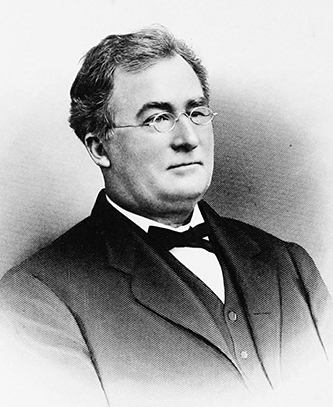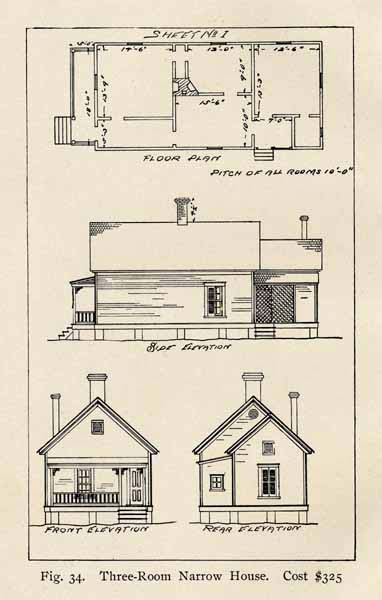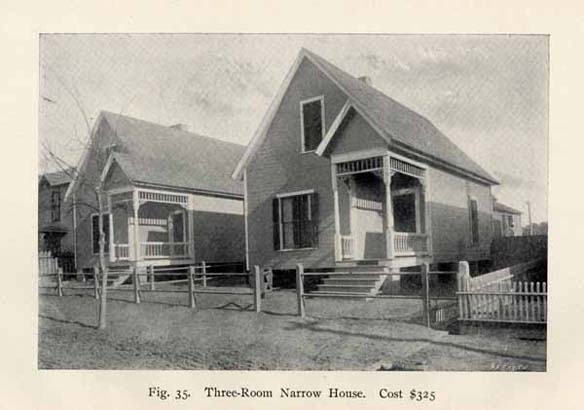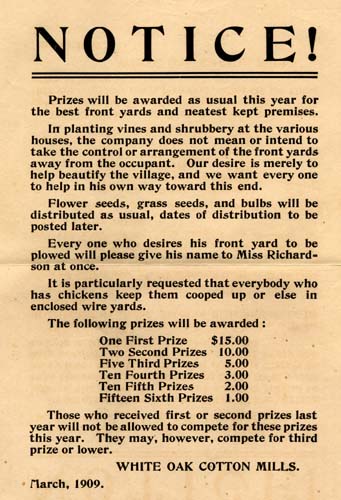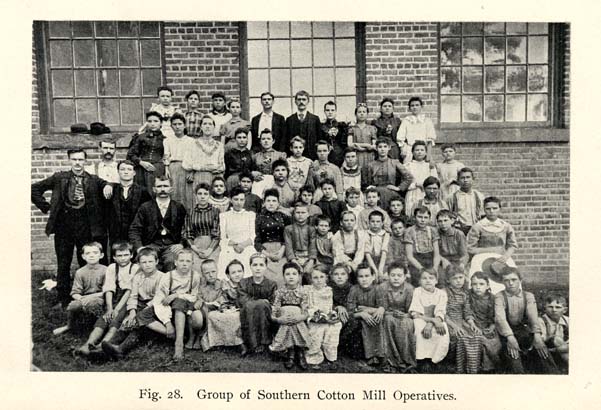Daniel Tompkins (1851-1914) was an industrialist and newspaper publisher who promoted the textile industry in the Carolinas. His book Cotton Mill, Commercial Features was subtitled "A Text-Book for the Use of Textile Schools and Investors," and it was intended to provide everything someone needed to know in order to run a successful textile mill.
In this excerpt from his book, Tompkins explains why mill owners should provide housing for workers close to the factories, and he gives pointers on design, construction, and sanitation.
Factories generally build houses for the accomodation of their operatives. There is a rough rule that the house ought to furnish one operative for each room in the house. Thus a factory with 300 employees, would require 100 houses having an average of 3 rooms each.
Factory houses are usually built around the mill, and form a little village to themselves. This seems at present the most satisfactory plan in the South, for both the mills and the operatives. They seem disposed to live to themselves and attend their own schools and churches even when the mill village is in a city.
In New England, the factories seem disposed to abandon the plan of owning houses for operatives. The operatives seem to prefer to own their houses or rent in locations of their own choice. It seems as if the general upward tendency is in this direction. As operatives become better educated and more prosperous, they will be less disposed to live in groups to themselves, and more disposed to mingle with people in other callings, thus acquiring a broader and more equable view of life.
New Designs
It was formerly the custom to build for operatives long rows of houses exactly alike, and in most cases adjoining one another. But it has transpired that this is not the best plan. Different families have different tastes, and as operatives grow in intelligence and prosperity, this differentiation in taste becomes more marked....
Where land may be bought by the acre at a reasonable price, plenty of room should be allotted to operatives houses. In fact the ability to get this room should be one important deciding factor in locating a plant. It is well to have half an acre for each house. If they stand in rows or streets, they should not be less than 75 to 100 feet from centre to centre. A half acre lot is just about the right size for the average lot. Most families have scant time to devote to gardening, because so many members of the family are occupied in the mill. Therefore a larger lot would be apt to be neglected. At the same time, it is well to encourage the planting of vegetables and flower gardens, as being conducive to general contentment among the operatives themselves, and as being an advantage to the mill company in making a cleanly and attractive property.
The whole matter of providing attractive and comfortable habitations for cotton mill operatives in the South may be summarized in the statement that they are essentially a rural people. They have been accustomed to farm life, where there is plenty of room. While their condition is in most cases decidedly bettered by going to the factory, the old instincts cling to them. The ideal arrangement is to preserve the general conditions of rural life and add some of the comforts of city life.
Failure to recognize this general principle has in at least one instance (known to the author) contributed to the utter failure of a large cotton mill located in a large seaport city. Operatives from country mills would be induced to go there, and would be subjected to the routine of strictly city life, which they could not learn to like. The result was that all good operatives (who could obtain work in their old districts) would leave, and the mill with strictly city environments was left with only the least competent operatives.
Sanitary Conditions
The sanitary condition of a mill village is very important. This must in all cases be looked after by the officers of the mill company. This is generally in the hands of the superintendent under direction of the president.
In most cases there are no water closets but only privies in the back yard. The mill company should in all cases make a permanent arrangement to have these kept well cleaned and the ground sprinkled with lime at least twice a week. While some of the families might attend to this, themselves, there are many families in which there is no one to attend to such matters. Separate families usually have no facilities for such work. The mill company can make a good and cheap arrangement to care for the cleanliness of the privies much better than the operatives can.
Arrangements should be made to inspect at regular intervals the operatives houses and yards. These are generally very well kept but sometimes one family would be careless, and the rest of the village would suffer if an inspector did not correct isolated faults.
Source Citation:
Tompkins, Daniel Augustus. Cotton Mill, Commercial Features. A Text-Book for the Use of Textile Schools and Investors. With Tables Showing Cost of Machinery and Equipment for Mills Making Cotton Yarns and Plain Cotton Cloths. Charlotte, N.C.: Published by the Author, 1899.
Published online by Documenting the American South. University Library, University of North Carolina at Chapel Hill. https://docsouth.unc.edu/nc/tompkins/menu.html
